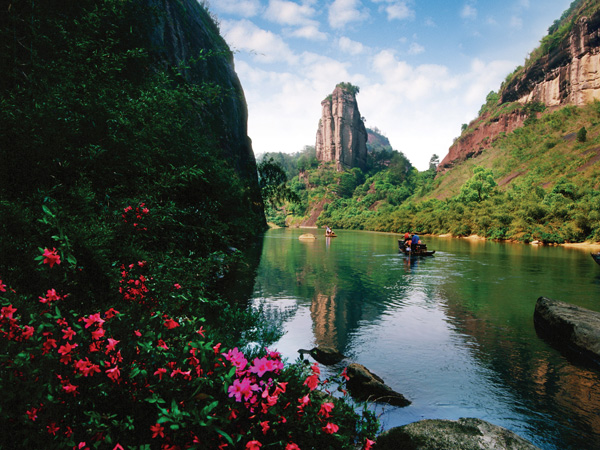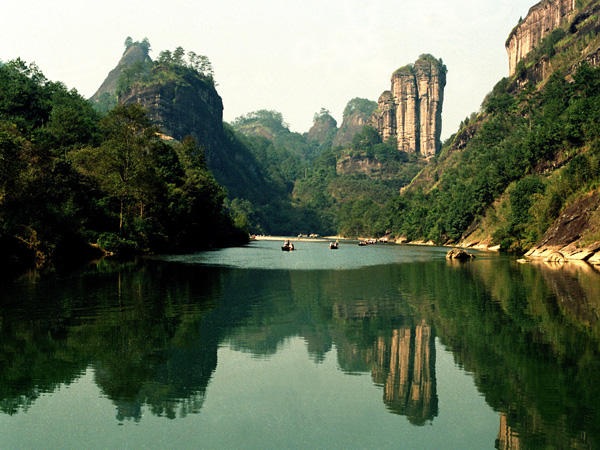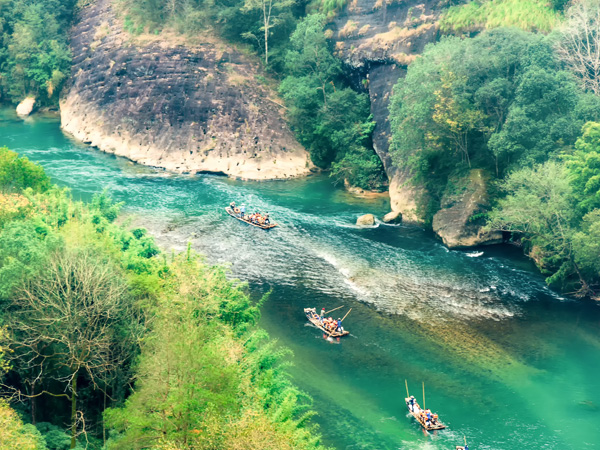Located at the junction of Fujian and Jiangxi Provinces, Wuyi Mountain is among the first group of China’s top tourist cities. In December 1999, Wuyi Mountain was listed as the World’s natural and cultural heritage by the UNESCO.
With a pleasant climate, fascinating scenery, abundant products, time-honored history and rich tourism resources, Mount Wuyishan is a famous tea, grain and timber production center in China. As early as the Western Zhou Dynasty (1100-771 BC), Wuyishan was well-known for its places of scenic and historical interests. Mount Wuyishan has a species-rich ecosystem, with 2527 kinds of plant species and nearly 5,000 species of wild animals. Mount Wuyishan belongs to typical Danxia landform. Except for the amazing Danxia landform here, the Daoism culture, Lingnan culture, tea culture and other historical and cultural heritages also attract tourists at home and abroad, especially those come from Singapore and Malaysia.
What to See in Mount Wuyi
Mount Wuyi Scenic Area is quite large. Attractions in the mountain is scattered and distance between each other is quite long. It is not recommended to visit all the sites in the mountain, but to see some main attractions, for time and energy consideration. With the combination ticket, you can reach the all the attractions inside. Main attractions inside Mount Wuyi area includes Heavenly Tour Peak, Wuyi Palace, Tiger Roaring Rock, A thread of Sky, Dahongpao Tea Trees, Water Curtain Cave, Nine-bend Stream, etc.
【Great King Peak】
Chinese Name: 大王峰,Chinese Pinyin:dàwángfēng.
Located at the outlet of Nine-bend Stream, Great King Peak is surrounded by precipices, and tourists can only climb up with the help of a ladder in a crack between two rocks in the south. A path leads to the top after passing through the ladder. There are several tourist attractions at the peak, such as Tianjian Pool, Toulong Cave, Crane Rock and the site of Shengzhen Taoist Temple. In the shape of a gauze cap, it is also called Gauze Cap Peak. In the Song Dynasty, a story about the Great King and Jade Maiden was spread far and wide. Since then the peak has become the symbol of the Great King, hence the name.
【Heavenly Tour Peak】
Chinese Name: 天游峰,Chinese Pinyin: tiān yóu fēng
Located in the central part of Wuyi Mountain, Heavenly Tour Peak, 410 meters above the sea level, is surrounded by Nine-bend Stream on three sides. Standing at the top of Heavenly Tour Peak, visitors can have a panoramic view of Mt. Wuyishan and the sea of clouds after rain or at dawn. Huma Mountain Stream at the top runs down directly from the peak, looking like a piece of white silk, hence the name of snow flake spring, which is a wonder in the mountain.
【Jade Girl Peak】
Chinese Name: 玉女峰,Chinese Pinyin: yù nǚ fēng.
In the shape of a pretty girl, Maiden Peak stands to the south of Nine-bend Stream and Two-bend Stream. It faces Great King Peak across the stream, with the Iron Slab Peak in the middle. At the foot of Jade Girl Peak lies Yuxiang Pond, which has a seal stone in it. Legend has that the seal stone was a token of love given by the Great King to Maiden. On the eastern side of Jade Girl Peak lies a round rock in the shape of a mirror.
【Nine-bend Stream】
Chinese Name: 九曲溪,Chinese Pinyin: jǐu qǔ xǔ.
Nine-bend Stream, call it Nine twists rivers if you wish, originates from the southern foot of Huanghang Mountain, flows to Wuyi Mountain via Star Village with nine bends and converges into Chong Stream in front of Wuyi Palace. Nine-bend Stream flows from west to east, each bend having its own unique landscape, and the water is so clear that the stone at the bottom can be seen. Along the winding stream, there are tranquil and secluded scenic spots, shoals and deep pools. One can float on a bamboo raft downstream from Star Village, or do drifting against the current from Wuyi Palace.
【Boat-shaped Cliff Coffins】
Chinese Name: 武夷山悬棺,Chinese Pinyin: wǔ yí shān xuán guān.
One of the mysteries of Wuyi Shan is the cavities carved out of the rock faces at the great heights that once held boat-shaped cliff coffins. Those coffins were installed there highly on the cliff over 4000 years ago .They are relics of the ancient Yue people’s funeral Traditions and as for why they were keeping this strange funeral tradition still remains unknown today. If you are taking a raft down the river, it’s quite possible to see some remnants of these coffins on the west cliff face of the fourth meaner or twist river.
Time Needed: Half an hour.
Location: If you take a bamboo rafting down the Nine Twists Rivers, those coffins will be at your left-hand side when you floating down around the fourth twist.
Ticket Fare: Included in the ticket of Wuyi Mountain Scenic Site.
Opening Time: Summer 6:30 to 18:00; winter 6:30 to 17:30.
【Thread of sky】
Chinese Name: 一线天,Chinese Pinyin: yíxiàn tiān.
The Thread of Sky locates in the south of the main Wuyi Mountains in a deep valley near the Second Twist River. There is giant rock that huge enough to cover three caves and it leaves a tiny gap less than one meter allowing light to squeeze through from the sky. After you have walked into the cave, at some point deep and dark enough, you will find yourself squeeze your body through two giant rocks in the dark with only tiny thread of light shining on you from the sky high above giving you a sense of a light coming from heaven.
Tel: 0599-5183166
Time Needed: 2 to 3 hours.
Transportation: Take No.6 bus from city center and get off at the Shangpunan Entrance(上埔南入口) stop, then take tour car in the Wuyi mountain scenic site, 18 minutes should be enough to take you there.
Ticket Fare: Included in the ticket of the Wuyi mountain scenic area which is 235 yuan.
Opening Time: Summer 6:30 to 18:00; winter 6:30 to 17:30.
【Xiamei Ancient Folk Houses】
Chinese Name: 下梅古民居,Chinese Pinyin: xià méi gǔ mín jū.
This village is mainly about those old stylish houses left from Ming and Qing dynasties with a history of over 200 years. Alongside their main water system called “dang xi” stream, there are delicate houses built along the two sides of the stream, as well as market, wells and ferries. For those who are interested in ancient Chinese architectures and caving works, this village will provide you with a tranquil feeling of as if walking through the old times.
Time Needed: 1 to 2 hours.
Transportation: The Xiamen ancient folk houses are located 12 km southeast to the city centre of Wuyi city. There are buses running to the village from downtown.
Ticket Fare: 60 yuan.
Opening Time: From 8:00 to 17:00.
【Wuyi Palace】
Chinese Name: 武夷宫,Chinese Pinyin: wǔ yí gōng.
Wuyi Palace located at the mouth of Nine-bend Stream was first constructed in the Tang Dynasty, and now preserves two Dragon wells, Wannian Palace and Sanqing Hall. At present, Wannian Palace serves as the memorial hall of Zhu Xi, and grows to sweet-scented osmanthus trees in the courtyard with over 1,000 years history, known as ‘king of sweet-scented osmanthus trees’. Now International Orchid College is located in Sanqing Hall, which holds four tables. The Song Dynasty Street which is 300-meter long starts from Memorial Hall of Zhu Xi, and passes by some historical sites, such as stone memorial archway, Sanqing Hall and Ancestor Peng’s Mountain House. Close to Song Dynasty Street, one can find the Mount Wuyi Villa and Manting Mountain House, showing the unique design style.
【Da Hong Pao Scenic Area】
Chinese Name: 大红袍景区,Chinese Pinyin: dà hóong páo jǐng qū.
Da Hong Pao Scenic Area is famous for Da Hong Pao (Big Red Robe) Tea Trees in rocks. You can enjoy the tea plantation and taste Da Hong Pao tea. See more of our tea articles, you could transfer to the Chinese tea culture page, which will tell yopu more about tea health and benefits. Another highlight of Da Hong Pao Scenic Area is the Eveer-Happy Temple, which is the largest Buddhist temple in Wuyishan Area.
About Touring Route in Mount Wuyi
As Mount Wuyi is quite larger and the attractions inside is scattered, it is suggested to take shuttle bus to travel between each other instead of hiking. But the fee shuttle bus is separated from entrance ticket. And normally, the Touring Route in Mount Wuyi Scenic Area can be divided into five parts, that is, Heavenly Tour Peak to Peach-Blossom Cave Area, Water Curtain Cave to Da Hong Pao Scenic Area, A thread of Sky to Tiger Roaring Rock Area, Yulin Pavilion to Lotus Peak Area, Wuyi Palace to Great King Peak. If you want to visit all the site in Wuyi Mountain area, it may take about three days. But for most of travelers, it is impossible for spend so many days in one place. So some popular tour routes around Mount Wuyi Scenic Area below are for reference for your trip plan, so that you can see the main sites in this place and enjoy your trip.
If you only have one day, it is recommended to visit Heavenly Tour Peak and Nine-bend Stream, which are two highlights of Wuyishan tour. Or Water Curtain Cave to Da Hong Pao Scenic Area tour route is also fine for a tea fan. If you have two days, you may visit take bamboo rafting along Nine-bend Stream and visit Wuyi Palace to Great Kind Peak in the morning, then visit Water Curtain Cave to Da Hong Pao Scenic Area in the afternoon in the first day. Then you may continue your trip to Heavenly Tour Peak, Peach-Blossom Cave Area, A thread of Sky to Tiger Roaring Rock Area in the following day.
What to Do in Mount Wuyi
【Take Bamboo Rafting along Nine-bends Stream】
The beauty of the landscape in Mount Wuyishan features by its streams and peaks. Nine-bends Stream in Wuyi Mountain area is known as the most beautiful stream in China. Taking Bamboo Rafting along Nine-bends Stream is a must do while you are traveling in Wuyishan. The boatman will explain the scenery on both sides of stream and tell the story about it for you along the way. Usually, the fee of Bamboo Rafting is not included in the entrance fee. You need to book it separately.
【Enjoy Impression of Da Hong Pao Show】
Impression of Da Hong Pao Show is a large-scale theater staged against real landscape and is directed by famous Chinese directors like Zhang Yimou, Fan Yue, Wang Chao Ge, who directed to Wuyishan true mountain real water for the stage, auditorium with 360° rotation, etc.. It is really a visual feast for visitors. The show tells the story of the beautiful legend of Wuyishan. It takes tea culture as the leading of the story. You may get a better knowledge of Wuyishan after watching the show.
Bamboo Rafting along Nine-bends Stream
Travel Guide
【Chinese name】: 武夷山
【Best time to visit there】: Wuyishan has warm and comfortable climate all year round, it are suitable for traveling. However, January to March is relatively dry and cold. April to June is rainy season rainy season, but the weather is cool and it is fine to travel during the time period. There is often typhoon in July and August and it is quite hot. If you travel to Fujian in these two months, the flight might be delayed or cancelled when typhoon comes. September to early November is the best time to visit Wuyishan, when the weather is cool, with less rain. And the scenery is beautiful as well.
How to get to Mount Wuyishan
Transport to Mount Wuyishan is convenient, flight, trains or buses.
【By Air】-recommended
There is a airport called in Wuyishan Airport, which is only 15 kilometers away from Mount Wuyi Scenic Area. usually, there are flights from big cities in China that travels to Wuyishan, such as Beijing, Shanghai, Guangzhou, Hong Kong, Macau, Shenzhen, Xiamen, Changchun, Shenyang, Dalian, Tianjin, Jinan, Hangzhou, Wenzhou, Zhengzhou, Xian, Whan, Haikou, Ningbo, Fuzhou, Kunming, etc. Upon your arrival, you may take a taxi or airport shuttle bus to reach Mount Wuyi Scenic Area.
【By Train】
There are direct trains from Fuzhou, Xiamen, Bejing, Shanghai, Quanzhou, etc. to reach Wuyishan. If there is no direct train, you may take train to arrive in Zhaowu in Fujian or Shangrao in Jiangxi first, then transfer to coach to reach Wuyishan. It takes about 1.5 hours from Zhaowu in Fujian to Wuyishan by car, 4 hours from Shangrao to Wuyishan.
1999, Wuyi Mountain was listed as the World’s natural and cultural heritage by the UNESCO.
Recommended Tour You Might Like

5 Days Xiamen and Mt. Wuyishan Tour
Mt. Wuyishan, Gulang Islet, South Putuo Temple, Hulishan Fort
View Details>>
More Information
- Wuyishan Airport


